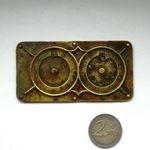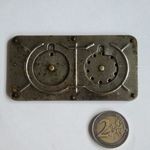

This is the Stephenson Adding Machine, or Stephenson's Adder. This one is made of brass, but there are also versions that are nickelplated brass. On the back is stamped the text "A.M. STEPHENSON, MFR.-JOLIET, ILL., AGENTS WANTED". It was probably made somewhere between 1896 and 1913.
It is a simple adder with two dials inside a frame. At the top of each dial the frame is cut away to reveal a number engraved on the dial, so that as the dials turn, different numbers are shown. On the frame around the right dial are stamped the digits 1 to 9. The dial itself has holes next to these digits into which you can put a stylus and then move the dial clockwise until the stylus his the tab at the top. When number shown by the right dial changes from 9 to 0, the left dial is moved anticlockwise to increase its number. The left dial can show any number from 0 to 19, meaning that the adder can show any number from 0 to 199.
This adder is used as a column adder. This means that you can only add single digits to its total, and when you want to add a list of larger numbers you used it to add them one single column of digits at a time. See the Aderes for further explanation.
To clear the result, rotate the right disk until it shows zero. You can do this either by rotating it clockwise until it carries, or by rotating it anti-clockwise until it cannot move any further. Then rotate the left disk anti-clockwise until it is zero. For this purpose it has a single hole in which you can put the stylus. When this hole is at the top, the left disk shows zero.
This is a clone of Stephenson's Adder. It is probably made of nickel-plated brass (it is not magnetic, except for the six rivets and the pawl axle). On the back is stamped the text "CIN SPECIALTY MFG. Co., M'F'RS, CINCINNATI, O". It was probably made somewhere between 1910 and 1914 and sold using the names "Perfection Adding Machine" and "Perfection Pocket Adding Machine".
It is virtually identical to Stephenson's adder. Even the decoration on the front is the same as some Stephenson's adders except for the spot at the top left corner where the axle for the ratchet pawl is located. The 1897 book "The Arithmachinist" by Henry Goldman has a picture of a Stephenson Adder with this exact decorative pattern.
Stephenson's Adder, or Stephenson's Adding Machine, was designed by Archibald Milton Stephenson (1844-1913). He first patented a 4-dial adder in 1873, at which time he was living in Manteno, Illinois. This adder was rather different to the 2-dial adder he was eventually to produce, and was probably not practical to use.
Stephenson's first adders (Type I) were plain, without decoration on the front. The detent on the left dial consisted of a leaf spring that pressed onto the teeth of the dial, ensuring that it would only shift one step at a time when a carry occurred. Unfortunately, it is likely that forcing the left dial clockwise could bend or break that spring. On the back of these machines it said "A.M. STEPHENSON, MANUFR", the patent number and date, together with the place name "BEARDSTOWN, ILL'S", or "WILMINGTON, ILL'S". The former are probably from the late 1870s, the latter from the early 1880s, as Stephenson seems to have moved town in 1879. These machines were also sold through agents, and some adders are known to have "C.B. SIMMONS, AGENT, OIL CITY, PA" stamped on the back, or "M. E. OAKLEY, CINCINNATI, OH" There are also machines marked "Fowler & Wells Co., New York, NY". This is a publishing company that produced the Journal of Phrenology and related publications. They sold a batch of these adders to their readers in the mid 1890s.
The second model (Type II) has a simple decoration on the front in the form of ridges encircling the dials and reaching out to the four corners. Internally there is now a sturdy metal ratchet pawl to block movement of the left dial in the wrong direction and to keep it from moving too far during a carry. On the rear it usually bears the text "A.M. STEPHENSON, MFR.-JOLIET, ILL., AGENTS WANTED". Stephenson settled in Joliet in 1895, and these machines appeared no later than 1899. This model was also sold and manufactured by others, especially because the original patent expired in 1900 and the new model did not have its own new patent.
The adder was listed in the Sears Roebuck catalogs of 1902 and 1903 as the Perfection Adding Machine, but it is not clear what inscription those bore. Some adders were made by W. B. Clark Manufacturing Co., Cincinnati, OH. Another clone was called the Tel-O-Flash Adder. The Cincinnati Specialty Manufacturing Co sold them under the name "Perfection Pocket Adding Machine" between 1910 and 1914. These had the text "CIN SPECIALTY MFG. CO., CINCINNATI, O". By 1918 this company switched to producing a retracting electric extension cord.
As late as 1926 Grover N. Mindling patented a small improvement of the machine (US 1,585,675, a stop tab for the left dial). He produced this adder between 1926 and 1929 as the Mindling Vest Pocket Adding Machine. It bore the text "G.N. MINDLING, MANUFACTURER, PITTSBURGH, PA".
Here's a video where I demonstrate Stephenson's Adder.
Here are some items relating to Stephenson's adder.
Here are items relating to the Cincinnati Specialty Manufacturing Company, and the adder called the Perfection (Pocket) Adding Machine. It is not clear whether all adders using that name were made by that company.
| Patent | Filing date | Publish date | Name | Description |
|---|---|---|---|---|
| US 137,107 | 25-03-1873 | 25-03-1873 | Archibald M. Stephenson | Improvement in Adding-Machines |
| US 1,362,344 | 04-12-1919 | 14-12-1920 | Fred F. Oakley, assigned to Cincinnati Specialty Manufacturing Company | Extension reel for electric lamps, portable drills, and the like (builds upon US 1,214,031 by Adam Heim) |
| US 1,585,675 | 20-05-1924 | 25-05-1926 | Grover N. Mindling | Mindling Vest Pocket Adding Machine |
© Copyright 2019 Jaap Scherphuis, mechcalc a t jaapsch d o t net.